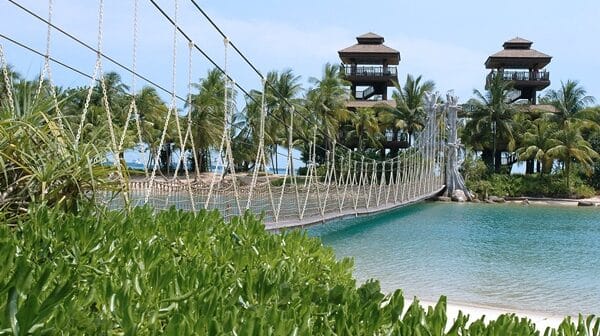Sentosa turns 50 years young this year!
Over the years, Sentosa has grown and continuously refreshed its offerings, transforming into a leading leisure destination and attracting some 19 million visitors annually (pre Covid-19). While many may know that the island was once a British military base, there are many other facets of Sentosa and its history that may be less well known to some.
As Sentosa kicks off celebrations for its Golden Jubilee with a slew of over 50 commemorative leisure experiences, we’d also like to share some interesting fun facts about the island that might surprise you!
Sentosa is home to more than 20 carefully conserved buildings
While we now know Sentosa as a multi-faceted leisure destination with its sandy beaches, exciting attractions, dining establishments, nature trails and resorts, it was once home to several villages and a British military base.
Did you know that the building housing Capella Singapore once accommodated officers of the British Royal Artillery and their families? Today, the heritage building has been integrated into the modern six-star resort. Surrounded by 30-acres of lush green landscape, Capella Singapore has also played host to the Bloomberg New Economy Forum and DPRK-USA Singapore Summit.
Sentosa could have been an oil refinery
In September 1967, Pulau Blakang Mati (as Sentosa island was then known as) was returned to the Government, following the closure of British military bases. During this period, plans were made to turn the island into an oil refinery. Thanks to a proposal by Albert Winsemius, then chief economic advisor to Singapore, as well as his team, Sentosa was instead transformed into a leisure destination for locals and tourists.
Sentosa’s “unofficial ambassador”? Peafowls!
Sentosa is home to rich biodiversity, with lush greenery and wildlife found across the island, including along its nature trails. As part of earlier efforts to enrich Sentosa’s flora, fauna and rustic charm, Sentosa welcomed its first pair of peafowls in 1980. Since then, the population of peafowls on Sentosa has grown to more than 60, illustrating the island’s conducive environment for wildlife and biodiversity to thrive. These peafowls comprise a mix of Indian blue peafowls and Javan green peafowls and are believed to be the largest number of peafowls in a single location in Singapore.
Fort Siloso has been gazetted as Singapore’s 74th national monument
Once known as Sarang Limau or Tiger’s Lair, Fort Siloso is the best-preserved 19th century fort in Singapore, serving as an important site to mark the nation’s war years.
The historic site has been gazetted as Singapore’s 74th national monument, with 11 structures that collectively tell Singapore’s defence story. This marks the first time that a site with structures has been gazetted as a National Monument.
Keen to find out more about Fort Siloso? As part of Sentosa’s Golden Jubilee offerings, guests can also experience more than 10 sustainability- and heritage-themed SentoSights tours, immersing themselves in rich history of the island, including Fort Siloso and Sentosa’s natural wonders. The ‘Letters from Blakang Mati’ and ‘Magical Discovery Sentosa’ tours will bring guests into Fort Siloso and show the fort’s history in a unique and enjoyable way.
Never-ending discovery on Sentosa! Find out more at https://www.sentosa.com.sg/jubilee




